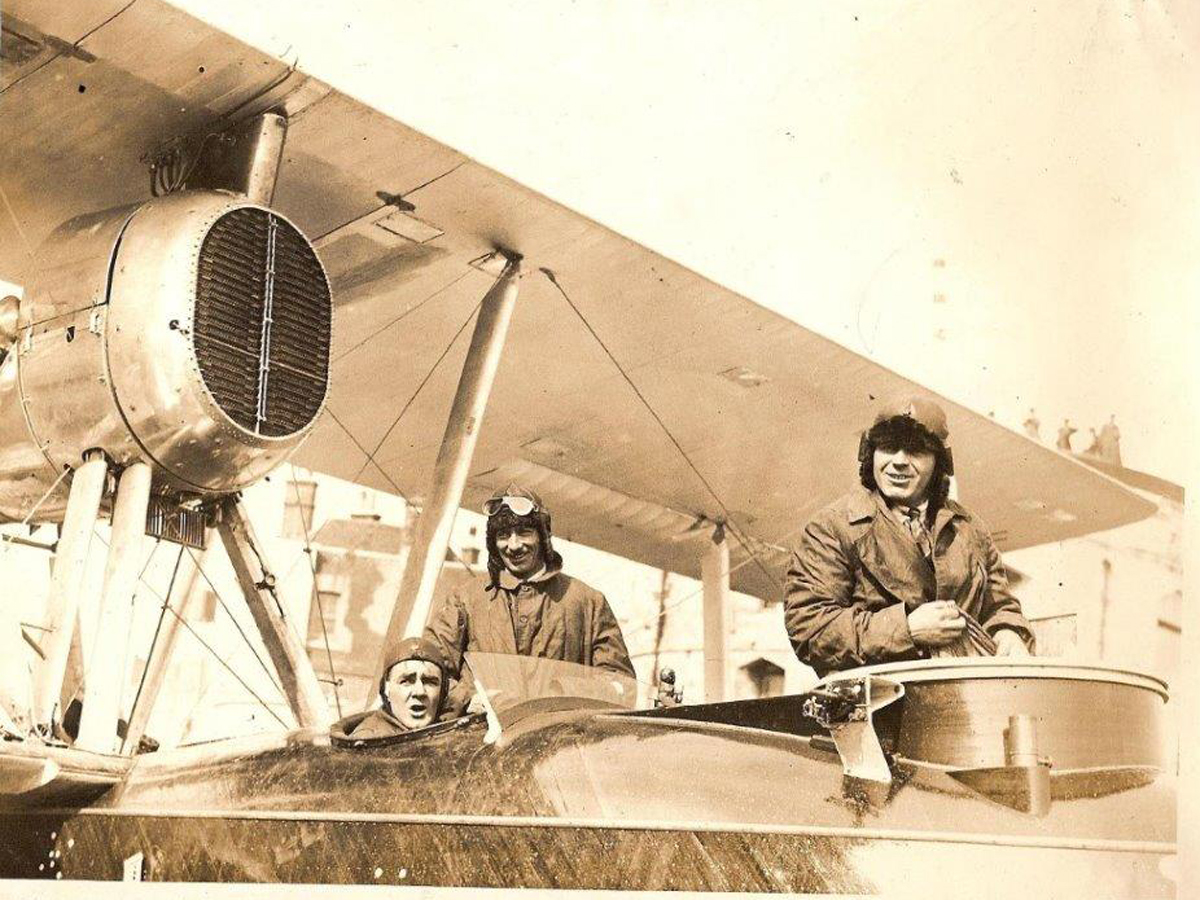Vickers Vulture: The amazing race
By Lookout on Jul 18, 2019 with Comments 0

Royal Air Force (RAF) Squadron Leader Archibald Stuart MacLaren and his crew aboard their Vickers Vulture used in their attempt to fly around the world in 1924.
Peter Mallett, Staff Writer ~
The granddaughter of a famous British aviation pioneer visited CFB Esquimalt’s Wardroom June 28 to see the iconic propeller from the Vickers Vulture aircraft used in his failed attempt to fly around the world 95 years ago.
Vanessa Ascough, 70, travelled from her home in Devon, England, to Vancouver Island to give a presentation about her grandfather at the B.C. Aviation Museum in Sidney. She also went to the Officer’s Mess to see the giant four-blade pusher propeller located on the south facing wall.
Few people know about its remarkable history.
The propeller was given to the Royal Canadian Navy as a gift from Ascough’s grandfather, Royal Air Force (RAF) Squadron Leader Archibald Stuart MacLaren. It was part of the single-engine amphibious plane used by MacLaren and his two-man flight crew in a highly publicized international race to become the first nation to fly around the world.
The propeller is precious to Ascough, but she is quick to point out the significance of the flight has been forgotten. As proof, she says the signatures of her grandfather and the two other crew members have not only faded but are covered by a large clock that was placed on the propeller at some point over the years.
“I have no idea how that clock got on the propeller and the sad thing is it covers the autographs. It is part of aviation history and it is still marvellous after so many years.”
Ascough, a former magazine editor at the University of Exeter, is writing a book about the flight to make certain her grandfather’s legacy is never forgotten.
She is also in possession of a silver model of the Vickers Vulture, his war medals, a silver rose bowl presented to him by the Japanese, and an atlas used by her grandfather to plot their course, which includes a description of each place they visited.
Because MacLaren’s military and flying legacy was seldom talked about in the family during the post-war years, Ascough was compelled to find out more about her grandfather and the flight.
“All these things were locked away in a cupboard when I was a child and never talked about. But I know I am meant to be writing his biography. I want the whole world to know about it because it is important.”
The Amazing Race
The Vickers flight crew departed Calshot, England, on March 25, 1924, in a mission financed by private donations. The flight path would take them in an eastward direction through France, Italy, Cairo, India, Burma and northward through East Asia.
Accompanying MacLaren were RAF Flying Officer W.N. Plenderleith as the pilot and Sergeant W.H. Andrews as their fitter and rigger. Their task had added significance because flight crews from the United States, Italy, Portugal, France and Greece were all competing to accomplish the milestone.
In their attempts, the Americans lost two planes in crashes, but remarkably none of their flight crew. One U.S. plane was lost after flying into a mountainside near Prince Rupert during a fierce blizzard, while another crashed in the Atlantic Ocean near Iceland.
Unfortunately, MacLaren’s Vickers Vulture also met a premature end when it crashed into the sea at Akyab, Burma, with no casualties. In a twist of fate, rival flyers from the U.S. had arrived in Tokyo and, in a show of sportsmanship, they helped MacLaren transport his backup Vickers Vulture, which was in packing cases in Tokyo, to Akyab via ship, and then aided in the assembling of the plane so their British rivals could continue in the race.
RCN to the Rescue
There would be more calamity for MacLaren’s team.
After travelling 21,082 kilometres and logging 195 hours and 15 minutes of flying time, their dream of winning the race ended abruptly when their second Vickers Vulture crash-landed in the Bering Sea.
They had no idea of their fate when they set off from Petropavlovsk-Kamchatskiy, Russia, on Aug. 4.
Heavy fog, rain and high winds forced pilot Plenderleith to set the plane down in the sea near Bering Island. The pilot got them down successfully despite a heavy sea running, but both wing tips wrenched off.
Support ship HMCS Thiepval and its crew plucked MacLaren and his men to safety from the icy waters. The 130-foot battle class trawler’s mission was to rendezvous with MacLaren and his crew in Hakodate, Japan, for the crucial leg of the Vulture’s northward journey to the Kamchatka Peninsula and then westward across the Bering Sea and through the Aleutian Islands to Alaska. The Royal Canadian Navy vessel was to supply the flight crew with aviation fuel dumps and other supplies. In the end, it was their rescue of the crew that proved most vital.
In thanks, the propeller was given to the Royal Canadian Navy by MacLaren, and the thermometer has been found to reside at the B.C. Aviation Museum.
Ascough never knew her grandfather, who had served as a soldier in the King’s Own Scottish Border Regiment in the early days of the First World War before taking to the skies. The war years and flying had taken its toll on MacLaren and he died at age 51 on Madeira Island, Portugal, while attempting to recover from lung disease.
So, who won the race?
The United States became the world’s first to fly around the world using four two-seat, single engine Douglas Aircraft, which were later renamed the Douglas World Cruiser (DWC). The Americans accomplished their mission when they returned to Seattle on Sept. 28, 1924, after completing a journey of approximately 44,342 kilometres.
Filed Under: Top Stories
About the Author:





